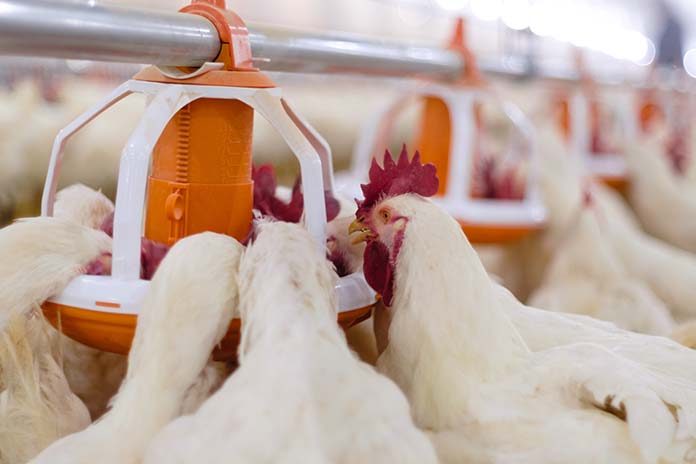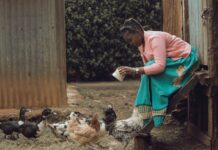
Dr. Keith Bramwell, a former professor in the Department of Poultry Science at The University of Arkansas, and Hatchery Consultant for Jamesway Incubator Company Inc. offers many useful practices and procedures for breeder management.
Dually noted, that both the males and females can be responsible for contributing to problems with fertility, the impact of the male on flock fertility is approximately ten times greater than the females, as this is the approximate ratio of males to females. Ultimately, fertility from the male standpoint depends on testes development, sperm quality and mating efficiency.
Continual selection for broiler traits doesn’t appear to negatively affect sperm quality however; today’s males tend to gain weight more easily, potentially leading to reduced mating efficiency and interest. Males are more susceptible to stress than females, due to the severity of their feed restriction, but the industry historically has placed greater importance on female brooding, rearing and production. Often time’s males have been left to ‘fend for themselves’, when in actuality they should have more attention due to their special needs during the stressful rearing period.
There are several elements to focus on to improve breeder management that can occur during the Brooding Phase, the Rearing Phase and the Production Phases. Important questions that must also be considered are; how can I keep more males alive? Why is my breeder uniformity poor? And why does my fertility drop off so fast, post 50 weeks?
During the early Brooding Stage, the chick has a developing immune system and inefficient temperature regulation. The chick processing and preparation in the hatchery can also cause stress, which can cause the birds to lose uniformity if they are not cared for properly. The damage caused in these first two weeks of life, may not become apparent until later in the chick’s life. It is important to create a ‘Comfort Zone’ for chicks in the Brooding Stage, so that the chick may have access to heat or cool, feed and water at all times. Equipment placement is critical in creating the perfect ‘Comfort Zone’ for your chicks, so that the chick does not have to make a choice between heat, feed and water; he has access to all elements at once.
Elements to consider while creating the comfort zone are, offering the required amount of feed space (100 chicks/per lid recommended), water space (80 chicks per drinker recommended) and allowing for both of these elements to fit comfortably within the ‘Comfort Zone’. The availability of clean, room temperature water is also strongly advised for creating the ideal ‘Comfort Zone’ for your chicks. Supplemental water is also highly recommended, in the snap on, easy to fill format. Placing paper under the water line will also help to attract chicks to the water. Insufficient early weight gain can be attributed to low feed consumption that may be the result of one of several other conditions. Essentials for a good start in chick growth are absorption of yolk and its nutrients which consists of 25% protein, 25% lipids, and 50% water and antibodies. Proper organ growth is essential for proper digestion in the chick, as the liver, intestines and pancreas grow 2-5 times faster than the body. The spleen and bursa weights relate directly to feed consumption of the chick, which in turn will equal the immunity level of the chick.
It is important to use enough feeder lids and enough feed in each feeder, so that all of the breeder chicks have access to feed and will have sufficient feed intake. If all of the feeder lids are constantly full of chicks, it means that there are an insufficient number of feeders available to the chicks. Insufficient feeder space and/or feed amount will affect feed intake, bird weights and bird uniformity. It is recommended that at least 1.4 kg of starter feed be fed to males for proper development and weight gains.
During the Rearing Phase, feeder space required for a Chain Feeder is 7.5” from 5 weeks to depletion and 1 pan per 8 males, from 5 weeks to depletion. It is essential that all males be able to eat simultaneously in order to maintain uniformity among the flock. Placement density must be 2.5 ft², minimum, per breeder and 1 nipple must be provided for each 8 cockerels, and 1 bell drinker for each 60 cockerels. If you cannot provide the recommended space required, males can still be reared and managed, in a manner to produce good fertility and hatch it is just much more difficult. There are many methods used that are not necessarily considered mainstream but if implemented accurately, they can result in good uniformity. To avoid any loss of the flock, it is important to focus on management ideas that will maintain uniformity and growth, especially if adequate floor and feeder space is limited.
During the Rearing Phase, males should never loose weight from week to week, and a loss, stall or decrease during the critical periods of this phase can result in a decrease in hatch potential for the life of the young breeder chicks. Critical periods during the Rearing Phase include the first few weeks, 8- 12 weeks, 18-21 weeks and the first 3 weeks after lighting.
Males are more forgiving from 24-30 weeks than lead to believe. It is important to have control of male weight and fleshing by 30 weeks of age. If a flock becomes off target body weight or fleshing then it is important to exercise caution when “bringing the males back to the weight curve”.
Checking ‘Vaccine Takes’ is also very critical in a good male program. Often times this practice gets pushed to the back burner and can become the demise of many good programs. Taking the time to check each flock is crucial as you never know what problems could arise. Excessive ‘takes’ will greatly affect the uniformity of the flock.
The third and final phase of Breeder Management is the Production Phase. During this phase there are many elements that must be considered in regards to housing. It is important to remember that the day prior to moving should be a feed day and that you should always move a complete house per day. Water should be readily available upon arrival and equipment change should be evaluated from rearing to lay house.
A good practice in breeder housing, is for male to female ratio to be within the range of 7.5-10.0%. Too high of a male ratio leads to male-male aggression, causing male mortality and mating interference. Too low of a ratio leads to male-female aggression, causing female mortality and an unreceptive hen. If the ratio of males falls below 7.0% the hatch will begin to become affected. However, these male-female ratios will need to be adjusted depending upon the breeder male selected as many of the new males on the market exhibit a much higher level of aggression than their predecessors.
Condition of the male must also be considered while housing, during the Production Phase. If the male is in excellent condition, there can be 7-8 males for every 100 females. Males in good condition require 8-9 males, males in fair condition require 9-10 males and poor condition males would be housed at 10-12 males for every 100 females, respectively.
The male aggression level may also be attributed to the weight or perhaps the breed of the chick, which could lead to mortality, slating, over-mating and interruption of mating. Synchronization with the female must also be considered, and fewer males should be placed if the male weight exceeds that of the female weight, by more than 30 percent. It is essential to always evaluate the condition of the flock and consider how many of the males are actually working within the flock. The number of males housed isn’t as important as the number of males that are actually performing.
Controlling the males’ weight gain and fleshing is essential during the Production Phase and bodyweight is one tool to help gauge the progress of the flock. Equally important tools to gauge the process are flock uniformity and condition, based on breast confirmation and fleshing. You should always handle males on a regular basis, and it is important to keep in mind that flocks can have similar average weights, but have a different body composition. The key to controlling the males is feed restriction.
By having a FOG (female only grill), and by placing male feeders at a level too high for the females to reach, you can attempt to control feed intake in both sexes.
Bird fertility also varies with age. There is a natural relationship between bird behaviour and physiology. As roosters age, they will gradually become less interested in mating and complete fewer matings, whereas the hen physiologically needs to be mated more often to sustain the same level of fertility. This presents the challenge of maintaining acceptable fertility in a 40+ week flock, as it continues to age.
Some common mistakes that are made while controlling the males are; not handling the males often enough, being unaware of how males are trending from previous fleshings and weights, not keeping feed cuts up with mortality and feeding too much to the better quality males. Other mistakes may also be; waiting on spikes to ‘fix’ fertility, poor equipment causing the inability to feed properly, allowing the males to get too large too quickly and trying to hold the males back once they have over fleshed post 30 weeks of age.
During the Production Phase, spiking programs may be implemented. There are three different types of spiking programs that can be incorporated into a breeder program, including the New Male Spiking, Intra Spiking and Back Spiking.
The New Male Spiking method utilizes young males, ages 25-27 weeks of age as the primary spike male. The Intra Spiking method utilizes older primary males from 2 or more houses and swapping them from one house to the next. The males used to spike with in this method are the same age as the primary males they are introduced to. Finally, the Back Spiking method utilizes males that were introduced to a hen farm as new spikes initially then they are pulled out prior to the sell of the hen flock to spike another flock. A spiking program can stimulate old males to increase their mating activity, lasting close to six weeks. Reactivation of short term fertility will result only if the males are still physically able to mate. As young males gain experience, typically taking anywhere from 4-6 weeks, their mating efficiency will also increase and eventually surpass the resident males. The optimum mating efficiency for spike males will occur around 9 weeks, post spiking. These combined effects from both the old and spike males will produce the desired response in flock fertility.
Spiking, although beneficial in many ways, can also present some negative effects as well. Biosecurity can be affected, presenting the threat of cholera, mites, and mycoplasma or other disease challenges. The biosecurity can also be affected by the different vaccination programs administered with different flocks. Multi age spike farms are not recommended and it is important to always bleed or PCR and have the negative results in hand before moving your spikes. Extra costs also incur with spiking, such as feed spacing, labor and equipment costs for moving the spikes. There is also the possibility that the spike house reared males may not always be ready when the flock is ready to be spiked.
Many aspects must be considered and great attention is required for breeder management. Focusing on what is actually happening and why, and evaluating the elements that can be changed for the better, will help to greatly improve fertility and subsequent hatchability.

















